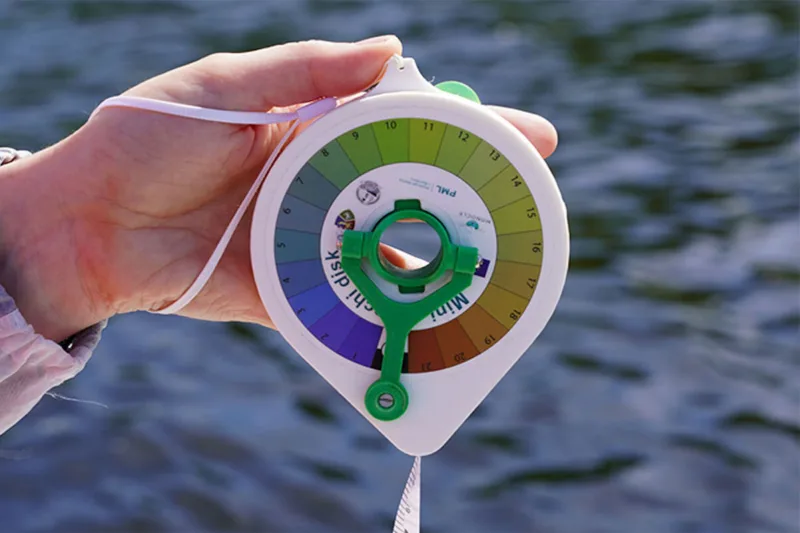Transparency/Turbidity
Overview
Students construct a mini Secchi disk to investigate transparency and the effects of increased turbidity from the increased flows as glaciers melt on aquatic and marine ecosystems.
Focus Question
- How does increased turbidity that results from melting glaciers affect the conditions for life in the streams?
Enduring Questions
- Climate patterns cause physical changes in the environment.
- Physical changes in the environment can change the conditions for life.
- Science and technology can be used to detect and solve problems.
Engagement
30-40 minutes
Distribute the Peninsula Online news article, “Small fry may be big problem” to students and ask them to read it to themselves.Then ask, “To what do scientists attribute to the small size of the salmon fry in Skilak Lake?” Ask students to recall what happened in the stream table when the water was poured over the soil. (water became cloudy)
Explain that when glaciers move, the ice scrapes over the ground or bedrock and grinds it up into very fine particles called glacial silt. When the glacier melts, this silt is washed out beneath the glacier and is deposited into the streams and lakes. It is so fine that it does not quickly settle to the bottom and can be suspended in the water, causing the water to appear cloudy or turbid.
Ask students to help develop definitions of transparency and turbidity: Water without any matter suspended in it would be completely clear or transparent, and light would pass right through it. Water has a certain capacity to hold matter in suspension until the density of the matter exceeds the density of the water, at which point the matter sinks. Any matter suspended in water scatters and absorbs light. Turbidity is a measure of the relative amount of light scattered and absorbed by water because of the suspended matter in the water.
Divide students into groups of 2 or 3, and give them the following list of terms:
- Changing Climate
- Glacier
- Hurricane
- Sediment
- Transparency
- Turbidity
- Light
- Phytoplankton
- Zooplankton
- Food Chain
Students should write each term on a sticky note and arrange them into a concept map on a piece of paper. After discussing the relationships of these ecosystem elements and developing their concept map, each student should copy the concept map into their science notebook, along with any questions they have.
Exploration & Explanation
50-60 minutes
Students will make a Secchi disk and use it to measure the transparency of the water, which will indirectly measure turbidity.
The following materials should be available for each group of students:
- Large containers with water (1,000 ml beakers)
- Powdered milk
- Ruler (with centimeters)
- String
- White plastic yogurt, sour cream, or cottage cheese container lid
- Nail or sharp object to make a hole in the lid
- Permanent black marker
- Pencil and data sheet
- Duct tape
- Nuts or washers to use for a weight
- Measuring cups
- Calculator
Divide students into small groups and distribute the Transparency/Turbidity Lab instructions.
Students will learn a method of measuring turbidity indirectly by measuring transparency with a Secchi disk. Using descriptions of a Secchi disk and materials provided, they will make a mini-Secchi disk and take measurements in a beaker.
Adapt the labs according to the abilities of your students, providing fewer or more instructions and example data tables if needed. You may wish to have them graph the data.
Explanation
25 minutes
The student lab instructions ask students to Analyze and Conclude. In their science notebooks, they will be completing the following:
Summarize your findings (the results of your experiments).
If you were on a boat in the ocean using a Secchi disk, what would your data collection table look like? Are there some variables you would need to control if you were taking measurements over time?
How do you think turbidity (the cloudiness of the water) might affect:
The amount of light that will pass into the water column and be available for photosynthesis by marine or aquatic organisms?
The amount of zooplankton available as food for young salmon and other fish?
How fast salmon fry and smolt can grow and their size at migration from fresh water to the ocean?
Do you think that rapidly-melting glaciers are most likely to increase or reduce water transparency in glacial lakes and streams?
Elaboration
10-15 minutes
When all the groups have finished, share and discuss the group responses to the questions as a class, and correct misconceptions.
Evaluation
10 minutes
Each student should return to the concept map in their notebook and revise it, adding new terms and connections, and changing it as needed.
Check science notebooks for responses to the lab questions.
Teacher Needs
Teacher Prep
About 2 hours to read materials, gather supplies, and prepare student materials.
Materials List
- Dice (1 per game board), game markers, sticky notes
- Internet access, Glacier Game Board #1 or Glacier Game Board #2
Student Needs
Prior Knowledge
Knowledge of effect of melting sea ice (from Investigation 1), experience or instruction in concept mapping.
Vocabulary
ablation, advance, aspect, copepod, crevasse, equilibrium, euphotic, firn, isostatic rebound, recede, retreat, terminus, transparency, turbidity
Standards
Science GLEs Addressed
6th Grade: SA1.1, SA1.2, SA3.1, SB1.1, SB3.1, SC1.2, SC3.2, SD2.3, SE2.1, SE2.2
7th Grade: SA1.1, SA1.2, SA3.1, SB1.1, SE2.2
8th Grade: SA1.1, SA1.2, SA2.1, SE 2.2, SE3.1

